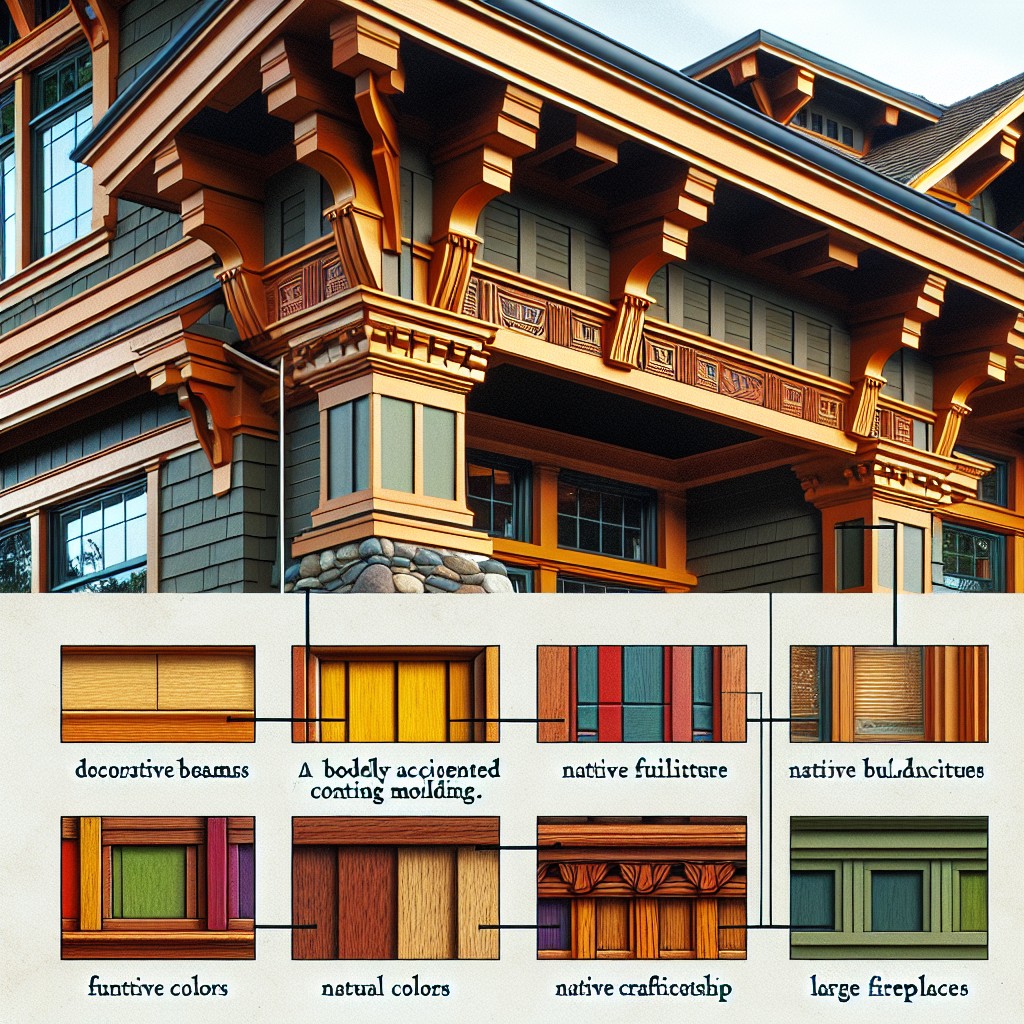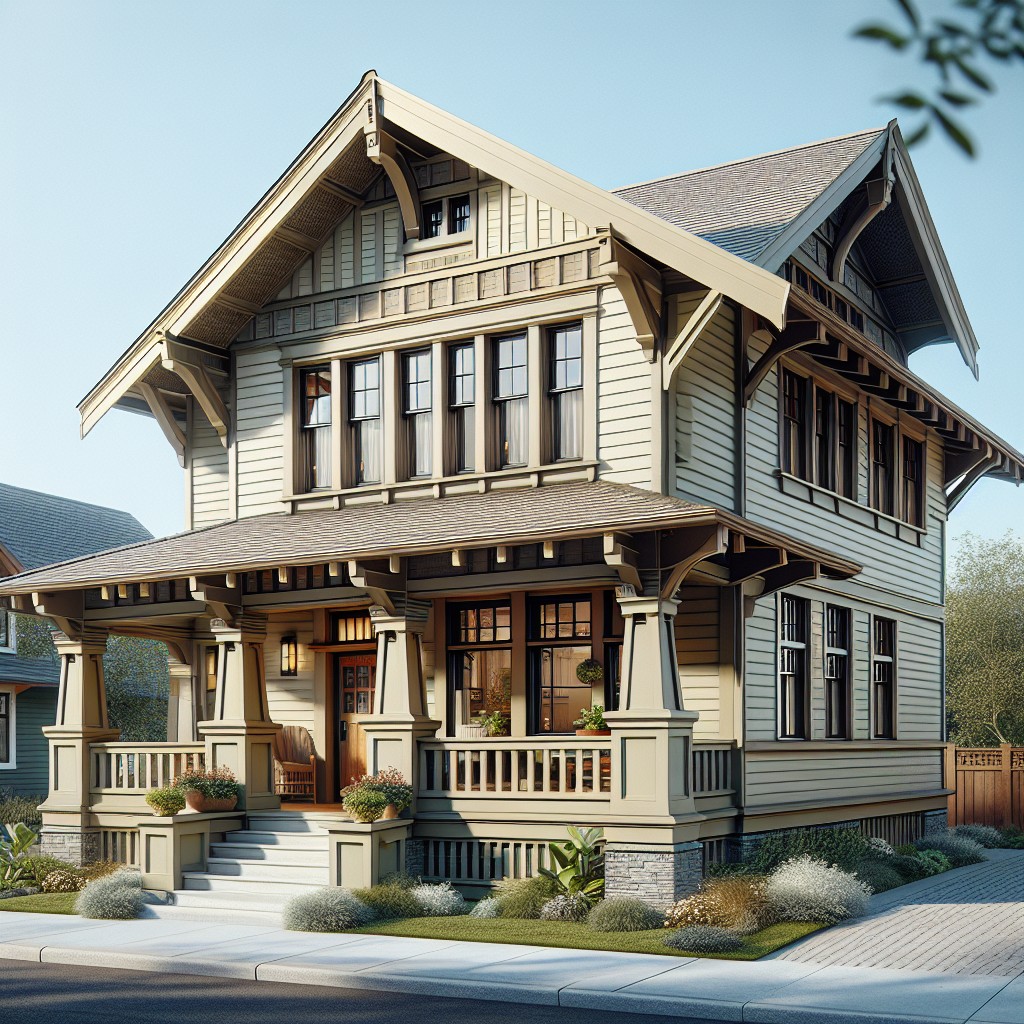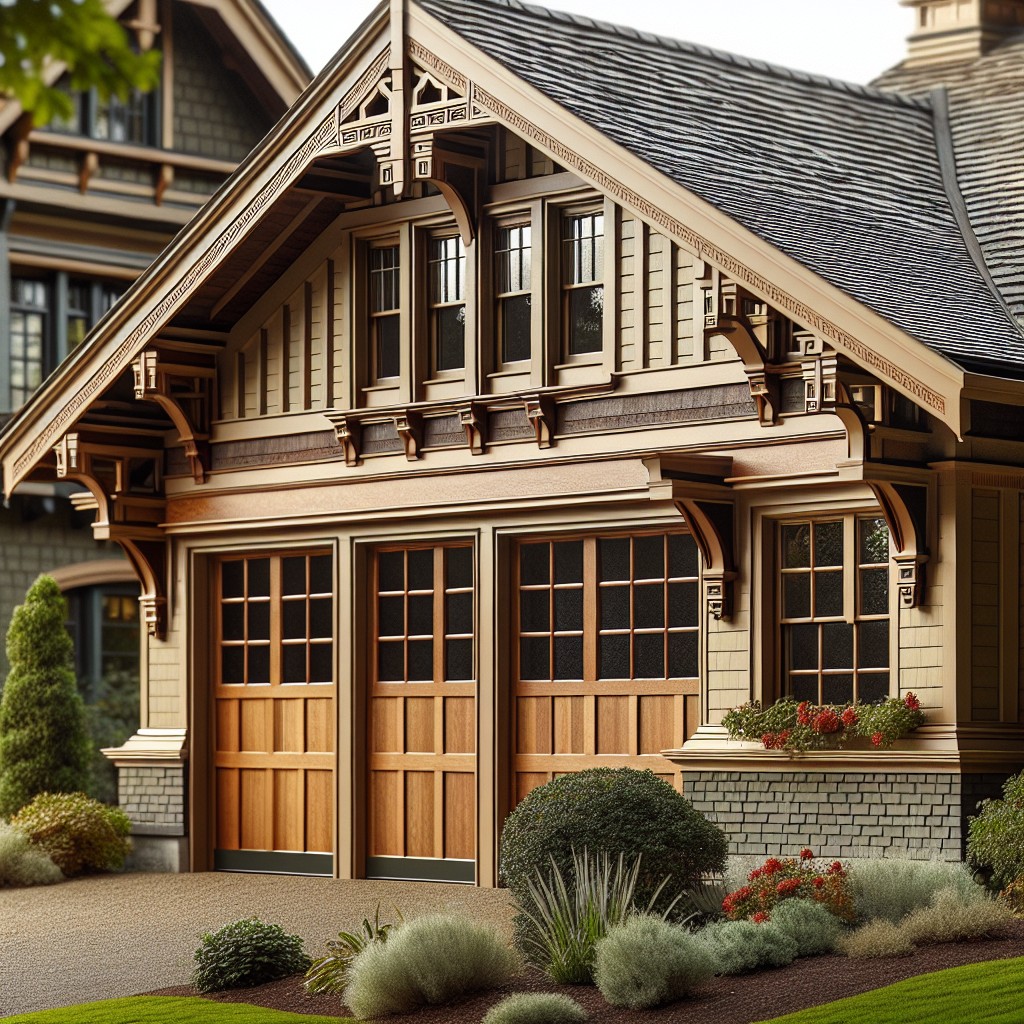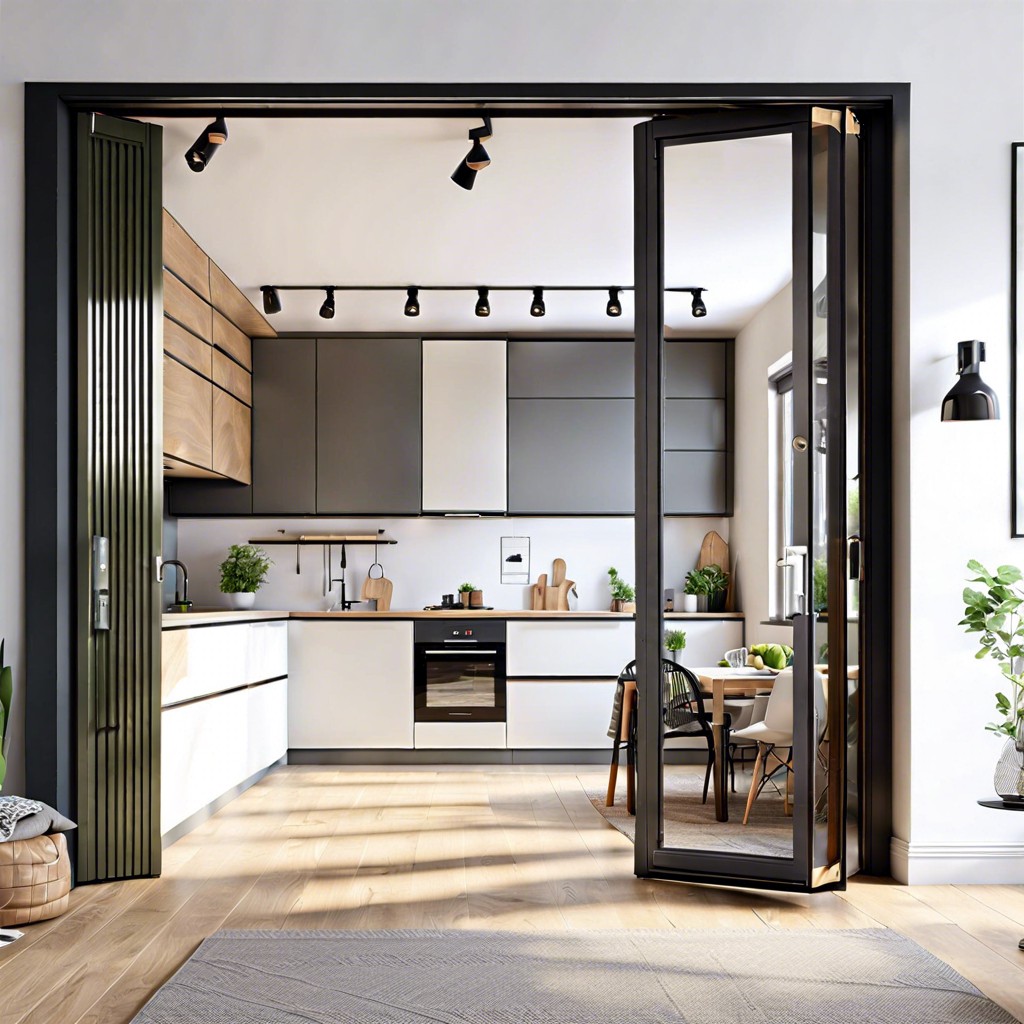Last updated on
Explore the timeless appeal of Craftsman style exterior trim ideas, because they effortlessly merge style and functionality, adding a charming touch to any home.
These are my unique design concepts made using design tools. I hope you find them inspiring!
Deep within the world of exterior home design, craftsman style trim stands tall; stunningly simple, captivatingly clean.
Many known and beloved ideas exist, yet space remains. Within this article’s folds exist the resource links to the best of these familiar concepts, sure to inspire.
But, the primary aim? To journey into the uncharted territory of craftsman style exterior trim ideas, curating a unique and innovative list to revitalize your design process.
Let’s dive in.
What's Inside
Boldly Accented Cornice Molding

Enhancing your home’s character with a cornice can create a strong visual statement.
For the Craftsman style, think about using wide and flat boards, which deliver an impactful shadow effect when the sun is low.
Painting the cornice a contrasting color draws the eye upward, amplifying the architectural features.
In addition, consider incorporating venting through the cornice to blend form and function.
This serves not only as an aesthetic choice but also promotes attic ventilation, marrying craftsmanship with practicality.
Rustic Stone Material Mixed Trim

Incorporating rustic stone into your trim can add texture and a natural touch to the Craftsman exterior. Here are key points on how to effectively achieve this aesthetic:
- Choose a color palette that harmonizes with the stone’s innate hues; typically, earthy tones work well.
- Utilize stone as an accent around entryways or windows to create a focal point.
- Contrast the roughness of stone with smooth siding materials for a tactile experience.
- Apply stone veneer along the bottom portion of your façade, capped by a wooden trim to delineate the transition.
- Ensure proper installation to weatherproof and avoid moisture issues, maintaining the integrity of the material over time.
- Consider the scale and proportion of stone trims in relation to the rest of your home’s exterior to achieve a balanced look.
Multi-patterned Window Trim

Incorporating different patterns into your window trim can create a visually striking effect, enhancing the classic Craftsman appeal. Here’s how you can add interest with multi-patterned window trims:
- Choose contrasting textures, such as smooth, flat boards against scalloped or wave-patterned shingles, to draw attention and add character.
- Mix geometric trim shapes, utilizing both square and rounded moldings, to frame windows for a unique artisanal look.
- Apply varying widths of trim, pairing wide sills with narrower side casings, to give depth and dimension to the windows.
- Consider installing patterned cutouts or overlays on the trim, such as diamond or sunburst shapes, which underscore the hand-crafted ethos of the style.
By blending patterns thoughtfully, you can emphasize the craftsmanship inherent in this architectural genre and make each window a standout feature of your home’s façade.
Pastel Trimmed Craftsman Style

Soft, serene pastel hues contrast beautifully with the robust, straightforward forms typical of Craftsman homes. These light, airy colors highlight intricate trim work without overwhelming the architecture.
- Choose muted tones like sage green, sky blue, or blush pink to accentuate natural wood or stone surfaces.
- Apply pastel on window frames, door casings, and porch columns to draw attention to these features.
- Consider the surrounding landscape when selecting a pastel—opt for shades that complement gardens and foliage.
- Use high-quality exterior paint with a satin or semi-gloss finish for durability and a subtle sheen that enhances the trim’s visibility.
Go Vertical With Red Brick Trim

Incorporating red brick as a vertical element along the corners or borders of your Craftsman home’s facade can enhance its architectural presence. This approach draws the eye upward, magnifying the home’s height and structure. When paired with horizontal siding, this contrast adds dimension and captures the essence of Craftsman design symmetry.
- To achieve a harmonious balance, consider using the same brick from the home’s chimney or foundation for a cohesive look.
- Use brick to frame doorways and windows, creating strong vertical lines that accentuate these architectural features.
- When choosing the width of the brick trim, ensure it complements the scale of the house to avoid overwhelming the overall aesthetic.
- Pairing the brick with neutral or nature-inspired siding colors can provide a striking visual that stands out while respecting the Craftsman tradition of natural beauty.
Triple Layer Window Framing

Enhancing visual depth, triple layer window framing involves three distinct elements: the inner trim, middle band, and outer casing. Together, they create a substantial, layered look, characteristic of Craftsman architecture. This approach not only adds heft to windows, but it also provides a bold outline against the siding, amplifying the handcrafted appeal.
When selecting materials, opt for wood in natural stains to maintain authenticity or painted finishes for a more contemporary twist. The innermost layer is typically the thinnest, drawing the eye inwards, while the middle band offers a chance for stylistic detail with molding textures or distinct color. The outermost layer, usually the widest, provides a strong outline, anchoring the window to the house’s exterior.
To achieve balance, ensure the width and depth of each trim layer proportionally complements your home’s scale. These frames echo the structural integrity that is at the heart of Craftsman design, making them both a functional and aesthetic choice.
Shingle-Textured Trim Style

Incorporating shingle-textured trim adds depth and character to a Craftsman exterior by embracing an element of artisanal texture. This engaging approach lends a tactile quality that’s both visually appealing and historically authentic. Use of cedar or redwood shingles provides durability and natural beauty, enhancing the classic Craftsman appeal. Paint them in a complementary hue to the primary exterior color, or leave them in their natural wood finish for a rustic touch.
When applying shingle texture to your trim, consider the following:
- Scale and Proportion: Ensure the size of the shingles fits the scale of the area being trimmed to maintain a balanced look.
- Symmetry: Align shingles uniformly for a cohesive design, as symmetry is a key component in Craftsman architecture.
- Color Blending: Select shingle tones that harmonize with the rest of the exterior materials for a cohesive color palette.
- Combination with Other Materials: Pair shingle trim with smooth siding or stone accents to create textural contrast, highlighting the unique Craftsman aesthetic.
Overhead Door Trim Design

Enhance your craftsman home’s appeal with thoughtfully designed trim around the overhead door. Opting for a prominent, wide trim mimics the effect of a solid frame, giving your doorway a sturdy and inviting appearance.
For a harmonious look, select trim that matches the window treatments, creating visual continuity. A header piece with a slight pitch or curved angle can emulate the classic craftsman style and draw attention upward, complementing the home’s architectural lines.
Consider using natural wood for a traditional touch or durable composite materials for a low-maintenance solution that retains the wood-like aesthetic. Integrate sconce lighting on either side of the overhead door to cast a warm glow and highlight the intricate trim details, ensuring your entryway stands out even after dusk.
Layered Horizontal Lines in Trim

Layered horizontal lines are hallmark features of Craftsman style, adding depth and architectural interest to the exterior. Implementing this design element involves stacking trim pieces at different levels to create a textured, tiered appearance. This technique not only reinforces the classic horizontal emphasis of Craftsman architecture but also visually grounds the home.
For maximum impact, consider these points:
- Choose trim widths wisely: Varying the width of the trim boards can create a visually appealing hierarchy. Typically, wider boards are used at the bottom with narrower ones stacked above.
Consistency in material: Utilize the same wood species or composite material across all layers to ensure a cohesive look.
Paint or stain for effect: Coordinating colors can unify the layers, while contrasting colors or stains can highlight the individual tiers.
Incorporating layered horizontal lines into your trim work can significantly elevate your home’s exterior by embracing the true essence of Craftsman style craftsmanship.
Craftsman Crosshead Trim

Embracing the structural elegance of Craftsman-style homes, crosshead trim adds a defining finish above windows and doors. These features typically boast a thick, horizontal beam that stretches wider than the opening, flanked by molding that adds depth and visual interest. The use of crosshead trim creates a harmonious balance between function and aesthetics by highlighting these architectural elements as focal points.
To incorporate crosshead trim effectively:
- Ensure the trim extends past the window or door width for a pronounced look.
- Select materials that complement the home’s existing woodwork and color palette.
- Consider adding keystones or dentil moldings to the crosshead for an extra touch of character.
By focusing on these details, homeowners can enhance the timeless appeal of their Craftsman exteriors while staying true to the design’s roots.
Decorative Corner Blocks for Windows

Elevate your craftsman exterior with decorative corner blocks that add a distinct architectural element to window surrounds. These blocks serve as visual anchors, drawing attention to your windows while enhancing the geometric design inherent to craftsman architecture.
Choose from a variety of materials, like wood or composite, to match or contrast with your siding.
Consider incorporating intricate carvings, such as rosettes or other period motifs, for added character.
Paint corner blocks in a complementary color to your trim to create a cohesive look or in an accent color for a pop of contrast.
Install them at both the top and bottom of window casings for a balanced appearance that frames your views meticulously.
Incorporate these blocks to simplify the installation of window trim, avoiding the need for mitered corners and thus reducing labor and complexity.
Window Panels With Check Trim

Integrating check trim around window panels adds a distinctive geometric aesthetic that mirrors Craftsman style’s emphasis on handcrafted detail and design symmetry. This trim often features a series of small square or rectangular blocks, known as “check” pieces, which line the outer edges of the window frame. These blocks can create a pleasing visual rhythm and can be painted in a contrasting color to the siding for a bold statement.
For a harmonious look, use wood that complements the house’s primary materials, ensuring that the check pattern is consistently proportioned across all windows. Considering the scale is vital; too large may overwhelm the window, too small may appear busy. For an authentic touch, choose natural finishes or stains to accentuate the wood’s grain, aligning with the Craftsman commitment to showcasing natural beauty in construction.
Custom Coffered Exteriors

Embracing a coffered design on your craftsman home’s exterior adds architectural depth and a timeless aesthetic. Often seen indoors, bringing this element outside creates a unique texture and visual appeal.
Consider incorporating a coffered design into your siding or along your porch ceiling to mimic the classic beam and panel look of craftsman interiors.
- Utilize faux beams made of weather-resistant materials to avoid structural strain and upkeep.
- Pair with subtle lighting to accentuate the coffered areas at night, enhancing the three-dimensional effect.
- Paint the recessed panels a lighter shade than the beams for a pop of contrast or a darker shade for a more subtle appearance.
- For consistency, coordinate the design with your interior coffered ceilings, if present, to create a cohesive look throughout your property.
Trim Ideas for Craftsman Porches

Porches serve as the welcoming arms of a Craftsman home, and your trim selection should invite both charm and cohesion. Opting for square or tapered columns can enhance the structural integrity while maintaining the traditional aesthetic.
Beadboard ceilings with exposed rafters, trimmed in natural wood tones, evoke an organic warmth, pairing beautifully with the Craftsman’s affinity for nature.
For handrails and balustrades, consider the robust, linear designs that pay homage to the Craftsman philosophy of strength and simplicity. Instead of intricate patterns, stick with straightforward, substantial balusters to underline the architectural style’s straightforwardness.
Accentuating the porch’s entryway with a prominent gable, using bold trim work, can create a focal point that captures the Craftsman spirit. Utilize wide trim around the front door to emphasize the entry and consider side-lites with grilles that mirror the window design, creating a seamless flow between the porch and the home’s exterior.
Dark Trim, Light House Combination

Contrasting a light-colored house with dark trim creates a striking visual impact that accentuates architectural details. This contrast highlights the craftsman silhouette and draws attention to the quality craftsmanship typical of this style.
Use deeper shades like black or espresso for window casings, fascia, and soffits to frame your home dramatically against a lighter siding.
Dark trim can also outline porch columns and railings, providing a cohesive look while making the structural designs pop.
Consider weather-resistant materials like fiber cement or vinyl for long-lasting elegance and minimal upkeep.
For an earthy craftsman appeal, opt for dark-stained wood that complements natural outdoor surroundings.
Unique Square Doorway Trim

Embracing a geometric approach to doorway design adds a contemporary twist to the traditional Craftsman aesthetic. Square trim creates a framed, distinguished entrance, drawing the eye and providing a clean, strong statement.
When selecting square trim:
- Opt for robust, natural wood materials to maintain the authentic Craftsman vibe.
- Consider the door color and finish; contrasting hues can highlight the angular trim.
- Keep the width of the trim substantial, which is in line with the Craftsman’s emphasis on woodwork.
- Apply a protective finish to the wood to both preserve the material and enhance its natural beauty.
- If the door has glass panes, choose a trim style that echoes the lines and shapes within the glass design for a cohesive look.
- Try incorporating subtle Craftsman motifs, like a small overhang or brackets, to maintain traditional elements.
- For added depth, use layered trim, with each subsequent layer slightly narrower, creating a tiered effect.
Craftsman Bungalow Trim Ideas

Embrace the quaint charm inherent to the craftsman bungalow style by highlighting its architectural features with well-chosen exterior trim. Selecting robust, straightforward materials like natural wood brings warmth and authenticity, staying true to the craftsman ethos.
Opt for wider trim around doors and windows to frame them prominently, enhancing the cozy, inviting atmosphere. Beams and rafters often extend beyond the roofline in these homes; emphasize this unique characteristic with contrasting paint colors that draw the eye while blending harmoniously with the main palette.
Earthy tones work especially well, grounding the property and reflecting its naturalistic inspirations. Adding trim with subtle decorative cuts can provide a touch of intricacy without overwhelming the simplicity of the bungalow style.
Wooden Outlining for Exteriors

Incorporating wooden outlining can enhance the natural charm of a Craftsman home. Opting for a species like cedar or redwood not only provides durability but complements the aesthetic with its rich texture and color.
These outlines can be layered to create depth or used to frame distinctive architectural features like gables or columns. They serve both a functional purpose, protecting against the elements, and an aesthetic one, highlighting the craftsmanship inherent to the style.
Stain the wood to preserve its innate beauty or paint it to match the home’s color scheme while maintaining its textural integrity. When installing, consider the wood’s natural expansion and contraction to ensure a lasting fit.
Trim Design Ideas for Detached Garages

Incorporating the right trim design on detached garages can harmonize your outbuilding with the main house, enhancing the overall aesthetic of your property. Consider these pointers:
- Echo the main residence by using the same trim color and style on your garage. This creates visual continuity and ties the buildings together.
- For a cohesive look, match the garage door trim with your home’s window trim, maintaining consistent thickness and patterns.
- Use thicker trim around the top of the garage to emphasize the roofline, which is a hallmark of Craftsman architecture.
- Installing knee braces under the eaves can add a structural and decorative element that resonates with Craftsman principles.
- If your garage has a second story or gables, employ decorative brackets or exposed rafters for an authentic touch that reflects Craftsman attention to detail.
- For lighting fixtures on the garage, choose designs with a Craftsman flair, using materials like hammered copper or bronze that can also be echoed in the trim work.
Ideas Elsewhere
- https://pvcmillwork.com/blogs/tips-and-tools/11-craftsman-style-exterior-window-trim-ideas
- https://windsorone.com/ideas/craftsman-style-exterior-trim/
- http://www.royalbuildingproducts.com/color-style/exterior-trim-visualizer/craftsman
- https://rwcnj.com/windows/everything-need-know-window-trim-styles/
- https://www.azdiyguy.com/blog//2015/09/super-easy-diy-craftsman-style-window.html




